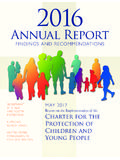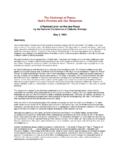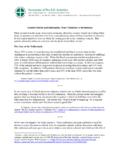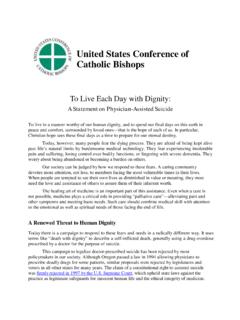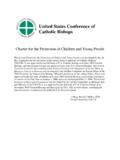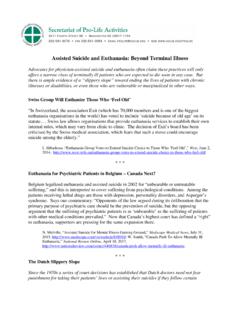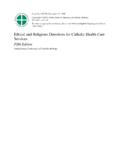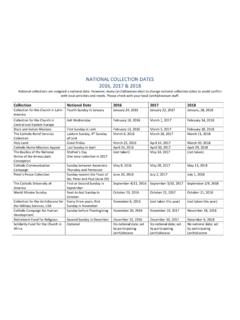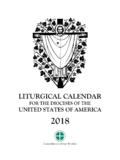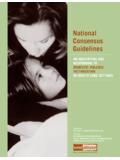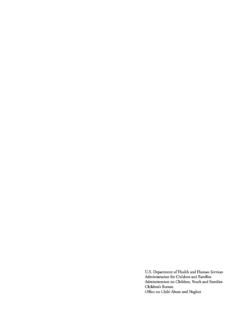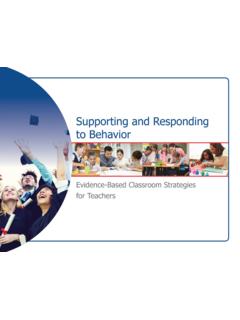Transcription of Ordination Class of 2018-final - usccb.org
1 Center for Applied Research in the Apostolate Georgetown University Washington, DC The Class of 2018: Survey of Ordinands to the Priesthood A Report to the Secretariat of Clergy, Consecrated Life &Vocations United States Conference of Catholic Bishops April 2018 Mary L. Gautier, Thu. T. Do, Table of Contents Executive Summary .. 1 Major Findings .. 2 Introduction .. 5 Part I: Ordinands to Secular (Diocesan) and Religious Priesthood .. 6 Part II: Age .. 8 Age When First Considered Priesthood .. 8 Age When Scheduled for Ordination .. 9 Ordinands by Year of Birth .. 10 Part III: Race/Ethnicity and Cultural Background .. 12 Race and Ethnicity .. 12 Country of Birth and Year of Entrance into the United States .. 13 Part IV: Education .. 16 Highest Level of Education before Seminary.
2 17 Attained Catholic Education .. 19 Participation in Catholic Religious Education .. 20 Home Schooling .. 21 Educational Debt .. 22 Part V: Work .. 25 Employment Background .. 26 Military Background .. 27 Part VI: Vocational Discernment .. 29 Family Religious Background .. 30 Siblings and Birth Order .. 32 Prayer Practices .. 33 Participation in Faith-Related Activities .. 34 Participation in Parish Ministries .. 36 Influence of Others .. 37 Participation in Vocation Activities .. 40 1 Center for Applied Research in the Apostolate Georgetown University Washington, DC The Class of 2018: Survey of Ordinands to the Priesthood Executive Summary This report presents findings from a national survey of seminarians scheduled for Ordination to the priesthood in 2018.
3 The report is a part of collaboration between the United States Conference of Catholic Bishops ( usccb ) Secretariat of Clergy, Consecrated Life and Vocations and the Center for Applied Research in the Apostolate (CARA). The purpose of this report is to compile information regarding men who are ordained to priesthood within a particular year. The data collection for this report involved identifying the responding ordinands to the priesthood in 2018 by contacting all theologates, houses of formation, dioceses, archdioceses, eparchies, and institutes of men religious in the United States for the names and contact information of all men scheduled for Ordination to priesthood in 2018 . The resulting contact list was used to administer the survey. The survey was administered between January 29 and March 11.
4 The survey invitation was sent by email to 430 identified ordinands. Follow-up emails were regularly sent to the ordinands who delayed their response and one follow-up email was sent to major superiors and vocation directors asking for assistance with encouraging the ordinands to participate in the survey. A total of 334 ordinands completed the survey (78 percent response rate). The responding ordinands included 252 ordinands to the diocesan priesthood (75 percent of all responding ordinands) and 78 ordinands to the religious priesthood (23 percent). Four responding ordinands did not report whether they belong to a religious institute or a diocese. 2 Major Findings Three-quarters (75 percent) of all responding ordinands are preparing for Ordination to a diocese or eparchy.
5 responding ordinands from religious institutes comprise the remaining 23 percent. The biggest group of responding ordinands (one-third) is completing studies at one of the seminaries in the Midwest. One in ten is completing studies at a seminary abroad. On average, responding diocesan ordinands lived in the diocese or eparchy for which they will be ordained for 17 years before they entered the seminary. responding ordinands from religious institutes knew the members of their religious institute on average for seven years before they entered the seminary. Age On average, responding ordinands first considered priesthood when they were 17 years old. responding ordinands were scheduled for Ordination on average 18 years later (at the age of 35). Since 1999, the average age of responding ordinands has fluctuated only slightly each year, from an average of 36 in 1999 to the current average age of 35.
6 Race/Ethnicity and Culture The majority of responding ordinands is Caucasian (seven in ten) and was born in the United States (three in four). One in four is foreign-born. By comparison, since 1999, on average each year, 30 percent of responding ordinands were foreign-born. The four most common countries of birth among the foreign-born are Mexico, Vietnam, the Philippines, and Colombia. On average, foreign-born responding ordinands came to live in the United States 12 years ago at the age of 23. Education About one in twenty (6 percent) responding ordinands report being home schooled. Those who were home schooled report nine years of home schooling, on average. Between 39 and 47 percent of all responding ordinands attended a Catholic school for at least some part of their schooling.
7 Half of responding ordinands (51 percent) participated in a religious education program in their parish for seven years, on average. Nearly half of responding ordinands (45 percent) report that they completed college or university undergraduate degree before entering the seminary. The most common fields of study responding ordinands who attended undergraduate or graduate school before entering the seminary are social science, theology or philosophy, business, or liberal arts. 3 One-half of responding ordinands (50 percent) entered their seminary program at the pre-theology level. A quarter (24 percent) carried educational debt, which averaged $27,241 at the time they entered the seminary. responding ordinands from religious institutes were as likely as those from dioceses to carry educational debt, but they were also more highly educated and on average their debt was smaller in comparison to responding diocesan ordinands.
8 Work Two in three responding ordinands (64 percent) reported full-time work experience prior to entering the seminary. One in five of those responding ordinands worked in education. responding ordinands for religious institutes are more likely than responding diocesan ordinands to have work experience (71 percent as compared to 62 percent). About one in eight responding ordinands (13 percent) reported that one or both parents had a military career in the Armed Forces. One in twenty responding ordinands served in the Armed Forces themselves. The percentage of those with experience in different branches of the military varies considerably from year to year. Vocational Discernment Almost all responding ordinands reported being baptized Catholic as an infant (90 percent).
9 Among those who became Catholic later in life, the average age of conversion was 26. Four in five responding ordinands (83 percent) report that both their parents were Catholic when they were children. One in three (35 percent) has or had a relative who is a priest or religious. More than seven in ten responding ordinands participated in Eucharistic Adoration (73 percent) on a regular basis before entering the seminary. The same proportion of responding ordinands (72 percent) prayed the rosary, half (48 percent) attended prayer group/Bible study, two in five (40 percent) went to high school retreats, one in three responding ordinands attended Lectio Divina (33 percent), and a quarter attended college retreats (27 percent). responding diocesan ordinands were 14 percentage points more likely than responding ordinands from religious institutes to participate in Eucharistic Adoration.
10 responding ordinands from religious institutes were 12 percentage points more likely than responding diocesan ordinands to attend college retreats. In regard to participation in various activities before entering the seminary, half of all responding ordinands participated in a parish youth group (45 percent) before entering the seminary. About three in ten responding ordinands participated in Catholic campus ministry/Newman Center (28 percent). In regard to participation in parish ministries before entering the seminary, nearly three-fourths of responding ordinands (74 percent) served as altar servers before entering the seminary. Nearly three in five (57 percent) served as lectors. Around a half served as Extraordinary Ministers of Holy Communion (46 percent).
